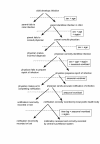Heterogeneity in regional notification patterns and its impact on aggregate national case notification data: the example of measles in Italy
- PMID: 12871599
- PMCID: PMC194854
- DOI: 10.1186/1471-2458-3-23
Heterogeneity in regional notification patterns and its impact on aggregate national case notification data: the example of measles in Italy
Abstract
Background: A monthly time series of measles case notifications exists for Italy from 1949 onwards, although its usefulness is seriously undermined by extensive under-reporting which varies strikingly between regions, giving rise to the possibility of significant distortions in epidemic patterns seen in aggregated national data.
Results: A corrected national time series is calculated using an algorithm based upon the approximate equality between births and measles cases; under-reporting estimates are presented for each Italian region, and poor levels of reporting in Southern Italy are confirmed.
Conclusion: Although an order of magnitude larger, despite great heterogeneity between regions in under-reporting and in epidemic patterns, the shape of the corrected national time series remains close to that of the aggregated uncorrected data. This suggests such aggregate data may be quite robust to great heterogeneity in reporting and epidemic patterns at the regional level. The corrected data set maintains an epidemic pattern distinct from that of England and Wales.
Figures









References
-
- Anderson RM, May RM. Infectious diseases of humans: dynamics and control. Oxford, OUP; 1991.
-
- Fine PEM, Clarkson JA. Measles in England and Wales: I, an analysis of factors underlying seasonal patterns. International Journal of Epidemiology. 1982;11:5–14. - PubMed

